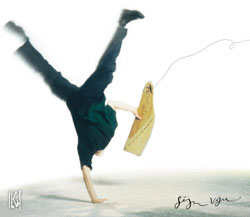
Sēju vēju (meaning “tie the wind” or “sow the wind”) begins forcefully, like the wind, and with a strong and energetic beat that continues through the first several songs. Thankfully, it doesn’t last. To be honest, I soon found the heavy drumming tiring, and much enjoyed the change to a few calmer songs about half way through the recording.
For example, “Es ar meitu dancot gāju” has the familiar, soothing strum of the kokle (the national instrument of Latvia and much of northeastern Europe). “Pūti, pūti, vēja māte” is also a treat: an a capella performance by Ilga Reizniece. But, it’s too bad “Pūti, pūti” is so very short and immediately followed by that familiar driving beat again. Luckily, the next song, “Uz Daugavas es dzīvoju”, is a wonderful men’s ballad with a guitar accompaniment—another treat that just makes you melt.
The members of the group have changed once again, but the signature of the Iļģi sound—Reizniece’s distinctive voice—remains. One also hears the men’s voices quite a bit and, even though they sometimes overdo the “macho” element, they are a welcome addition. The bass guitar and drums are more prominent on Sēju vēju than on previous recordings, but Ilgi still rely on a variety of traditional instruments. Folk music conservatives may not like the “Indian yell,” as one folk music authority called it, that starts off the compact disc, nor the other whoops, yells and trills. They are not what one would consider reserved, northern or Latvian sounds.
The texts of the songs are all Latvian dainas, which are ancient verses passed down orally over hundreds, even thousands of years. Even though dainas are usually about agrarian life, they are timeless, and have obviously adapted very well to modern music, as one can hear on Sēju vēju. There is a motif of strength, energy and activity to the lyrics: they are about the wind, the ocean, young men, horses, searches for brides—all very fitting lyrics for the abundance of men’s voices that one hears on this recording, the powerful upbeat music, and, as the liner notes hint, the pace of modern life in general. The translations on the whole are good, though I found some to be lacking in detail or depth of explanation, as is usual in all translations.
Iļģi used to be considered a traditional folklore group, but they have come a long way from their original sound. This CD is definitely not for those with a narrow view of what Latvian folk music is. In fact, I wouldn’t really consider this folk music. It’s “world music” that really rocks. Sure, the traditional influence in the texts and melodies is very strong. But this is definitely rocky, with a touch of the bagpipes and a reminder of a barn dance here and there. I’ll even admit that the first couple of times around the CD was a bit too heavy for me.
But…I do support what Iļģi are doing. I really like and appreciate this experimenting, mixing of, and playing with traditional and modern musics. On a recording from 1993 Iļģi eloquently called it a “conversation between ourselves, in the presence of others who lived and sang here hundreds and thousands of years ago;” “the manifestation of creativity stimulated by traditional music,” and “the evolution, rather than the destruction, of the folk song.” The Celts have been doing this sort of thing for years, the Scandinavians are now into it, and, with such a rich traditional culture from which to take inspiration, it’s about time for the Latvians to pick up on it, too. Iļģi were ahead of their time and began their self-defined “post-folklore” many years ago, and with each new recording they seem to go a bit further.
If you don’t mind the heavy beat, Sēju vēju is another fine album from by far the best known world music group in Latvia. It has some really great songs—“Seši jauni bandenieki,” “Aiz upītes meitas dzied,” “Seši mozi bundzenīki,” and (my favorite) “Uz Daugavas es dzīvoju.” All in all, this CD is very catchy, and it’s beginning to grow on me! I’m finding myself humming melodies from it all day long. But, I will stress that it’s not for folklore purists.
(Editor’s note: This article originally appeared on SVEIKS.com.)
Details
Sēju vēju
Iļģi
Upe Records, 2000
UPE CD 016
© 1995-2024 Latvians Online
Please contact us for editorial queries, or for permission to republish material. Disclaimer: The content of Web sites to which Latvians Online provides links does not necessarily reflect the opinion of Latvians Online, its staff or its sponsors.




